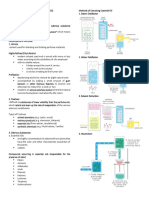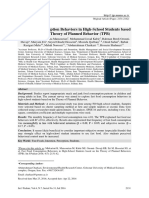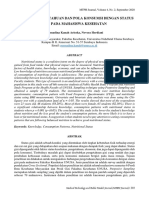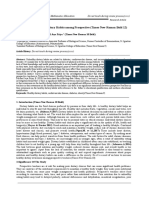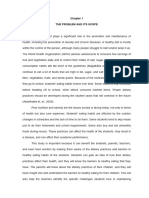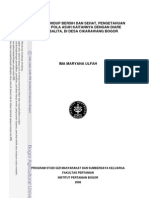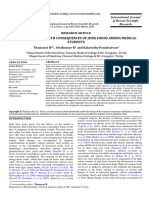71
71
Uploaded by
Muhd SyarafuddinCopyright:
Available Formats
71
71
Uploaded by
Muhd SyarafuddinOriginal Description:
Copyright
Available Formats
Share this document
Did you find this document useful?
Is this content inappropriate?
Copyright:
Available Formats
71
71
Uploaded by
Muhd SyarafuddinCopyright:
Available Formats
303
ANALYSIS OF ATTITUDES AND WILLINGNESS TO HEALTHY FOODS
AMONG STUDENTS OF NON STATE SECTOR HIGHER EDUCATIONAL
INSTITUTES IN MALABE SUBURB
Jayasekera, J.M.T.K., Gunasekara, M.A., Ariyathilaka, S.K.L., Kosgahakumbura, K.N.M.H.H.,
Thalangama, P.A.K.L and Priyadarshani, W.M.D
Department of Biosystems Engineering, Faculty of Engineering, South Asian Institute of Technology and Medicine
(SAITM), Sri Lanka. Email: deepika@saitm.edu.lk
ABSTRACT
Unhealthy dietary habits are major risk factors for chronic diseases, particularly if adopted during early
years of adulthood. Limited studies have explored the food consumption patterns among young adults in
urban private sector higher educational institutes. Our study aimed to examine common dietary patterns
and their correlates among a large sample of university student population in Malabe suburb. Study was
carried out on 105 students, using a self-administered questionnaire. Different dietary patterns were
observed among male and female students. We observed significant differences between males and
females in terms of their reported food intake and dietary patterns. The attitudes towards healthy foods are
varying among female and male students. This survey results revealed that health promotion programmes are
needed to address the dietary intake and life style behaviors of young adults in private higher educational
institutes.
.
Key words: Healthy foods, dietary habits, higher educational institutes
1. INTRODUCTION choice varies with availability , cost , benefits
and sensory appeal. This willingness and
It is well known that unhealthy dietary habits are accessibility differs from adults to youth
among the major risk factors for obesity and generation in consuming healthy food.
related chronic diseases. In particular if those
dietary habits are adopted during early adulthood Youth generation usually develop their own
[1,2]. They are becoming more frequent due to the system to buy what they need which reflects their
nutritional transition that is affecting populations personal ideology and beliefs from food
across developing countries [3,4], where traditional products. Rapid changes in physical growth and
healthy diets are replaced by westernized dietary psychosocial development have placed these
patterns. young adults as nutritionally vulnerable groups
with poor eating habits, that fail to meet dietary
University students seem to be the most affected requirements [6,7]. This situation is more or less
by nutrition transition. These dietary behaviors similar in Sri Lankan University context too.
are mostly attributed to drastic changes in the Therefore presents study is conducted with
environment and resources available, frequent following objectives.
exposure to unhealthy foods and habits [5].
Therefore healthy food consumption is an This research survey was designed to study, the
important factor that assists to maintain bodys attitude and awareness among students of private
daily functions; optimal body weight; disease higher education institutes in Malabe sururb on
prevention and at a glance maintaining physical consuming healthy food, to determine the
and mental wellbeing of the life. willingness and accessibility to healthy food
gender vise and the residence of students, and to
According to Federal Drug Administration identify what factors affects mostly to the
(FDA) healthy foods are Foods which are low students willingness, necessity and accessibility
in fat and saturated fat , limited in amount of in consumption of healthy food.
sodium and cholesterol and provide at least 10%
of one or more of vitamin A ,vitamin C, Calcium,
protein and fiber (for single item foods). 2. METHODOLOGY
Many factors impact a persons willingness to 2.1. Study Setting and Population
consume healthy food, from age to culture , from
This cross-sectional study was conducted among
income level to tradition from location of
105 students at three private higher educational
residence to health knowledge and the food
International Research Symposium on Engineering Advancements 2015 (RSEA 2015)
SAITM, Malabe, Sri Lanka
304
institutes located in Malabe suburb, Colombo Majority of students (66.7%) reside at boarding
District of Sri Lanka by using universal or rental places in comparative to 21.6%
sampling. Respondents were asked to participate respondents reside at home. The rest of the
in this study voluntarily. Objectives of the study sample which comprise 11.8% respondents reside
was printed in the questionnaire and explained at their relatives places.
orally whenever necessary.
Eating patterns and food choices:
2.2. Study instruments Regular breakfast consumption among university
A self administered questionnaire was used as a students is important for sufficient energy intake
survey instrument which included series of open to overcome fatigue due to busy (daily) learning
ended questions where respondents were asked to schedule. In this study, majority of respondents
mark their response on the sheet. The flow of the had breakfast daily. According to the survey
questions were concerned about the age group, analysis 7.9% male respondents and 6.8% female
residence, usual place of obtaining breakfast and respondents usually miss their breakfast. Data
lunch, usual composition of their diet, revealed that 39.5% of male respondents and
dependence of their willingness to healthy food 54.2% of female respondents usually have rice
based on body posture, health, and sexuality. and curry for their breakfast. Very less amounts
from both genders have string hoppers (7.9%
The validity of the questionnaire was assessed by male and 3.4% females) for their breakfast.
conducting a pilot study. The sample survey 15.8% of males and 8.5% of females have bread
carried out including the above mentioned facts for their breakfast. There are considerable
provided us with a reliable amount of data to amounts of respondents who have short eats for
conduct the data analysis. The data were analysed their breakfast as a habit representing 28.9%
on the basis of gender and residential places of males and 27.1% females. This revealed the
the students. change in the dietary habits among young
2.3. Statistical Analysis generation.
The Statistical Package for Social Sciences Changes in living arrangements are considered as
(SPSS) version 19.0 was used to analyze the data one of the main factors influencing dietary habits
in this study. of university students. Mainly those who live
away from the parental home develop more
undesirable nutritional habits..Most of the
3. RESULTS respondents coming from home have rice and
curry for their breakfast (50%). 13.6% of them
105 students completed the questionnaire. Of usually have string hoppers and bread. A
these, 2 questionnaires were rejected due to considerable amount (18.2%) has short eats for
improbable replies, resulting in 103 usable their breakfast. 4.5% of them do not have their
questionnaires. The analysis was carried out breakfast. Respondents who live at boarding
mainly based on the gender and residence of houses, 44.4% usually have rice and curry for
students. The relationship between the gender their breakfast, 3.2% have string hoppers and
and residence with the willingness, accessibility, 11.1% usually eat bread. A considerable amount
attitude and nutritional knowledge of the students of students residing at boarding houses (34.9%)
was analyzed in depth. The sample population eat short eats for breakfast . 6.3% of them do not
was assumed to be homogeneous, excluding the have breakfast.T hose who are coming from
impact of other factors such as social status, relatives house, 63.6% have stated that they
money, existing disease conditions etc usually eat rice and curry, 0.0% are usually eating
string hoppers ,another 9.1% are usually eating
Demographic features of sampling group: bread , 9.1% eat short eats while 18.2% are not
The majority of the sample was females (60.2%). having their breakfast.
Among three higher educational institutes, 56.9%
of the respondents represented SAITM where as One of our objectives was to find out whether the
30.4% and 12.7% from SLIIT and CINEC students having a healthy dietary pattern.
respectively. Among the respondents 16.5% According to the survey analysis 2.8% male
belong to 15-20 years age group, 81.6% were respondents and 1.6% female respondents dont
between 21-25 years and 1.9% belongs to 26-30 have their lunch usually. From the analyzed data
years category. One of our main objectives was it can be clearly seen that 80.6% from male
to find whether the residence of students affect respondents and 90.2% from female respondents
their dietary pattern and healthy eating habits. usually have rice and curry for their lunch. The
International Research Symposium on Engineering Advancements 2015 (RSEA 2015)
SAITM, Malabe, Sri Lanka
305
general dietary habit during lunch time is shown grains at all, proves that. None of the respondents
in the Figure 1. coming from home have eaten whole grains more
than 4 days during the week of survey. 36.4%
1.00% have eaten whole grains one day, 22.7% for 2-3
Rice and days and 27.3% students for 4 days. Of the
2.10% 2.10%
Curry students who are boarded, 38.7% havent eaten
8.20% Fried rice whole grains last 7 days while, 33.8% have eaten
only in a day, 27.9% in 2-3 days, and no one has
Short eats eaten for 4 days or more than 4 days. From the
students who come from relatives house 25.0%
Snakcs havent eaten whole grains during last 7 days
86.60% while, 16.7% have eaten only in a day, 25.0% in
2-3 days ,25.0% in 4 days and 8.3% 0f the
Don't have
respondents have eaten more than 4 days.
lunch
From all Female respondents 26.2% hadnt
consumed milk products during the week of
survey. From all male respondents 22.0% hadnt
consumed milk products during the week of
Figure 1: Dietary patterns during lunch survey.19.5% from male respondents and 18.0%
of female respondents have consumed milk
The frequent consumption of snacks and light products around 5-7 days. When comparing the
meals is a recognizable aspect of teenage food analyzed data of consumption of milk products
behavior [8]. Of the 21.4% of respondents who and consumption of whole grains, it can be
come from home, 13 have only short eats for clearly seen that more amount of students had
intervals and 4.5% have only soft drinks. A fair consumed milk products more than whole grains
amount of students (50.0%) eat both short eats
and soft drinks during interval. 31.8% drink tea
or coffee. Out of the 68 students who come from
boarding houses, 4.6% have only short eats for
0 days
intervals and 13.8% have only soft drinks. A 18.60%
considerable frequency of students (50.8%) have 24.50% 1-2 days
both short eats and soft drinks. 21.5% drink tea 24.50%
32.40% 3-4 days
or coffee and 9.2% have stated that they are
taking other food. From the students who come 5-7 days
from relatives house, 25.0% have only short eats
for intervals, 33.3% eat both short eats and soft
drinks, 25.0% drink tea or coffee and 16.7 have
other food types. Here the impact of religious and
Figure 2: Consumption of fat free or low fat
ethnical beliefs on food choice of the students
milk products by students within a week
and probability of having students with chronic
diseases which restrict diet was neglected. The
From those who are coming from home 27.3%
results show that majority of the respondents had
havent consumed milk products during last 7
traditional rice and curry for breakfast and lunch.
days. A similar amount of students (27.3%) have
Most of them were not affected by availability of
consumed milk products for 1-2 days and 5-7
junk food.
days. 18.2% of students have taken milk
products for 3-4 days. Out of the respondents
34.1% from all male respondents and 30.6%
who come from boarding house 22.4% havent
from all female respondents havent consumed
consumed milk products during last 7 days. A
whole grains during the week of survey. Only 1
considerable amount (32.8%) have consumed
student from all the male students have
milk products for 1-2 days. 26.9%have taken
consumed whole grains more than 4 days during
milk for 3-4 days and 17.9% for 5-7 days. From
the week of survey. None of the female
those who are coming from relatives house
respondents have consumed whole grains more
25.0% havent consumed milk products during
than 4 days during the week of survey. So from
last 7 days, 41.7% have consumed in 1-2 days,
the analysed data it is clear that the consumption
25.0% in 3-4 days and 8.3% in 5-7 days. As a
of whole grains among the respondents were
whole more students have taken milk products for
considerably in a low amount. From all the
1-2 days.
respondents 32.0% hadnt consumed whole
International Research Symposium on Engineering Advancements 2015 (RSEA 2015)
SAITM, Malabe, Sri Lanka
306
From all Female respondents 16.1% hadnt Accessibility to food:
consumed fruits during the week of survey. From When comparing the places of having the
all male respondents 14.6% hadnt consumed breakfast majority of the respondents (39.8%) use
fruits during the week of survey. Higher institute canteen to have their breakfast,
percentages of both female respondents and male according to the analysed data. Least amount of
respondents consume fruits 1 2 days .From the respondents have their breakfast from an outside
total respondents it is about 47.6%.From the shop. It is about 11.2% from all the respondents.
analyzed data it can be seen that 15.5% from total 24.5% respondents have their lunch from the
respondents hadnt consumed at least one piece boarding place. From the male respondents
of fruit during the last week. So it proves 15.5% majority of the students around 45.9% have their
from total respondents wont get essential breakfast from institute canteen. Very few amount
nutrients which fruits contain. of male respondents have their lunch from
boarding place. From female students least
A considerably large amount of students coming amount of students have their breakfast from an
from home (45.5%), boarding houses (48.5%) outside shop. When comparing the places of
and relatives place (50%) have consumed at least having the lunch majority of the respondents use
one piece of fruit for 1-2 days during the week of institute canteen to have their breakfast,
survey. 3 students coming from home, 12 according to the analyzed data.46.3% from all
students from boarding houses and 1 student from male respondents and 37.7% from all female
relatives house havent consumed at least one respondents use the institute canteen to have their
piece of fruit during the week of survey. lunch. Least amount of male respondents have
their lunch from the boarding house. It is about
When considering about the consumption of 4.9% from all the male respondents. 12.7%
vegetables except for 1 male respondent all the respondents have their lunch from the boarding
other respondents contained more than 3 types of place. When comparing more amount of
vegetables in their meal. 34.1% of male from respondents have their breakfast from the
male respondents and 43.5% of female from boarding house than their lunch. From the male
female respondents had had a meal with more respondents majority of the students around
than 3 types of vegetables in 5 -7 days in their 46.3% have their lunch from institute canteen.
meal. As a total 39.8% respondents have a meal Very few amounts of male respondents have their
containing more than 3 types of vegetables. lunch from boarding place. From female students
Those who are coming from home have least amount of students has their lunch from an
responded that all are having more than 3 types of outside shop.
vegetables in their meals. Out of them 18.2% are
having more than 3 types of vegetables in 1- 2 One of our survey objectives was to find which
days. 27.3% in 3-4 days and 54.5% in 5-7 days. factor mostly affect when buying food from an
Those who are coming from boarding house have outside place. According to the respondents
responded that except for 1.5% all the others are majority from male respondents consider Taste
having more than 3 types of vegetables in their when buying a food. It had been recorded as
meals. Out of them 22.1% are having more than 3 36.4% from all the male respondents. The factor
types of vegetables in 1- 2 days. 42.6% in 3-4 which is least considered among male
days and 33.8% in 5-7 days. Those who are respondents was the price of the food.
coming from relatives house have responded that According to the female respondents majority
all are having more than 3 types of vegetables in consider Health when buying food from an
their meals. Out of them 41.7% are having more outside place. It can be seen from the percentage
than 3 types of vegetables in 1- 2 days. 8.3% in 3- 46.3% which has been recorded out of all the
4 days and 50.0% in 5-7 days. female respondents. According to the chart it can
be seen which factor mostly affected in each male
and female categories.
Taste
100% Dietary patterns:
Percentage
Price Majority of the respondents from both genders
50%
Health were non vegetarian. None of the Male
0% respondents didnt represent the lacto vegetarian
Male Female Distance
(who dont eat eggs, but eat dairy products)
dietary pattern. Only 1 female respondent
Figure 3: Reasons considered by students represented the lacto vegetarian dietary
when selecting an outside place to buy food pattern.70.7% of male respondents represented
International Research Symposium on Engineering Advancements 2015 (RSEA 2015)
SAITM, Malabe, Sri Lanka
307
the non-vegetarian pattern from the male confirm whether the students have ability to get
respondents and least male respondent amount healthy food from their institute canteen. From
was represented by the lacto ovo vegetarian the male respondents More than half of the
group. From female respondents majority students were affected by lack of food to buy
represented non vegetarian group while only which leads to missed meals and intake of low
8.1% represented semi vegetarian (those who eat nutritional value foods.
mostly vegetable and occasionally eat meat)
dietary pattern. More female respondents Willingness to consume healthy food:
represented the lacto ovo vegetarian group A majority of both male (58.5%) and female
compared to the male respondents. When (71%) respondents are willing to buy herbal
compared more percentage of male respondents porridge if they have easy access. A fair amount
represented the semi vegetarian groups than the of male respondents (41.5%) are not willing to
female respondents. In the survey 58.6% of buy herbal porridge, on the other hand it is 29%
female respondents were non vegetarian and among female respondents. A fairly lower
41.4% of male respondents were non vegetarian frequency of male students (38.8%) and a
when compared gender vise. The type of dietary comparatively higher frequency of female
pattern was considered because it plays a major students (61.3%) are willing to consume cereals.
role in healthy eating A fair amount of both male (43.5%) and female
(56.5%) participants are not willing to buy
Access to healthy food: cereals even if they have gained easy access. As
In this research one of our main objectives was to the method of intake of the cereals are varying,
confirm whether the students have ability to get from all the male respondents 40.0% liked
healthy food from their institute canteen. From processed cereals 26.7% liked cereal related
the male respondents 17.1% agreed that they food,23.3% liked homemade cereals and 10.0%
have access and ability to get healthy food from liked prepared curries. Considering all the female
the canteen. 82.9% denied and opposed to the respondents 46.0% liked processed cereals 22.0%
idea of having access to healthy food in their liked cereal related food, 26.0% liked homemade
canteens. From the female respondents 27.9% cereals and 6.0% liked prepared curries. When
agreed they have access and ability to get healthy considering all the respondents,34.3% male and
food from the canteen. 72.1% female respondents 65.7% female respondents liked to consume
from all the female respondents denied and processed cereals, 42.1% male and 57.95 female
opposed to that idea of having access to healthy respondents liked to consume cereal related
food in their canteens. Also 73.7% SAITM fod,35.0% male and 26.0% female respondents
students, 77.4% SLIIT students and 84.6% liked to consume homemade cereals and 50%
CINEC students have agreed that they do not from both male and female respondents liked to
have access to buy healthy food in their institute consume cereals as prepared curries. From those
canteen. So as the majority of respondents who are coming from home, 61.1% are taking in
opposed to the idea of having the accessibility to cereals as processed cereals, 16.7% as cereal
healthy food in their canteens, we can presume related food, 11.1% as homemade cereals and
students are not exposed to an environment another 11.1% as prepared curries. From those
having healthy food in their educational who are coming from boarding house, 39.2% are
institutes. taking in cereals as processed cereals, 27.5% as
cereal related food, another 27.5% as homemade
cereals and 5.9% as prepared curries. From those
100%
who are coming from relatives house, 30.0% are
80%
Percentage
taking in cereals as processed cereals, 20.0% as
60% cereal related food, 40.0% as homemade cereals
40% NO and 10.0% as prepared curries.
20% YES
0% Nutritional knowledge:
SAITM SLIIT CINEC A considerably large amount of both male
(57.5%) and female (70%) agreed that having a
Higher education institute variety of fruits and vegetables is important in a
healthy diet. 20% of male respondents and 15%
Figure 4: Students response to availability of of female respondents disagreed with this fact
healthy food in canteen whereas10% of male students and 6.7% of female
students were not sure about this fact. A lower
In this research one of our main objectives was to amount of male participants (12.5%) and female
International Research Symposium on Engineering Advancements 2015 (RSEA 2015)
SAITM, Malabe, Sri Lanka
308
participants (10%) said that sometimes this fact is food. From all the male respondents 2.4% said
not important. As a whole a majority of the that it is due to influence by another person,7.3%
respondents are quite knowledgeable about said that they wanted to improve their mood,
nutrition. 75.6% said that it is to their overall wellbeing and
14.6% said that other. From all the female
Idea on selecting healthy food: respondents, 3.3% said that it is due to influence
Respondents were asked for their preferences in by another person,9.8% said that they wanted to
four categories. The first investigated category improve their mood, 80.3% said that it is to their
was how the selection of healthy food affects the overall wellbeing and 6.6% said that other.
Body posture. From all the male respondents
8.3% said that they wanted to be slim,36.1% said Attitude towards healthy food:
that they wanted to improve their current Respondents were asked to select a statement
weight,19.4% said that they wanted to improve among five statements to find out the attitude
their flexibility and coordination and 36.1% said about healthy food. As a total, the most selected
that they wanted to improve overall body shape. statement was Food containing all main
From all the female respondents, 18.3% said that nutrients in appropriate proportions. From all the
they wanted to be slim, 20.0% said that they respondents,76.9% male and 23.1% female
wanted to improve their current weight, 35.0% respondents think that any type of natural food
said that they wanted to improve their flexibility which is made without artificial ingredients as
and coordination and 26.7% said that they wanted healthy food.34.0% male and 66.0% female
to improve overall body shape. respondents think that healthy food is a food
containing all main nutrients in appropriate
The second category was Health Dependant. propotions.37.5% male and 62.55 female
According to the survey analysis from all the respondents think that a food suitable for physical
male respondents,10.0% said that they wanted to and mental health is a healthy food.36.0% male
be resistant to diseases, 5.0%said that they and 64.0% female respondents think that healthy
wanted to improve their cardiovascular system, food is a food which can maintain a healthy
32.5% said that they wanted to improve their lifestyle.
health, and 47.5% said that they wanted to
improve their overall health. From all the female Satisfaction: Considering the satisfaction of the
respondents, 16.7% said that they wanted to be healthiness of the food, from all the male
resistant to diseases, nobody said that they respondents 41.5% said that they are satisfied and
wanted to improve their cardiovascular system, 58.5% said that they are not satisfied. From all
18.3% said that they wanted to improve their the female respondents, 37.1% said they are
health, and 65.0% said that they wanted to satisfied and 62.9% said they are not. From all
improve their overall health. the respondents it can be clearly seen that
majority of the respondents, 61.2% are not
The third category was Sexuality Dependant. satisfied with the healthiness of the food they
According to all male respondents, 15.8% said consume. Results show that more than half of
that they wanted to be attractive to opposite sex, both male and female respondents were not
18.4% said that they wanted to be sexually satisfied with the healthiness of the food that they
desirable, 28.9% said that they wanted to improve eat.
their attractiveness, and 36.8% said that they
wanted to improve their muscle tone. From all the
female respondents, 8.5% said that they wanted 4. CONCLUSION
to be attractive to opposite sex, 5.1% said that
they wanted to be sexually desirable, 66.1% said In conclusion, we found that dietary patterns
that they wanted to improve their attractiveness, differed among university students; students who
and 20.3% said that they wanted to improve their are coming from their home has more access to
muscle tone. healthy foods.. Health promotion programs and
evidence based educational interventions are
Majority of the female students wanted to needed to promote healthy eating and active
improve their attractiveness whereas a majority lifestyle behaviors among young adults in urban
of male respondents wanted to improve their higher educational institutes. Furthermore, given
muscle tone. the importance of exploring dietary patterns
rather than the intake of individual nutrients and
As the final category we looked in to other foods in relation to health, further studies are
factors that affect for the selection of healthy needed to explore determinants of dietary
International Research Symposium on Engineering Advancements 2015 (RSEA 2015)
SAITM, Malabe, Sri Lanka
309
patterns among various populations, and more
importantly, the association between identified
dietary patterns and health outcomes, including
obesity and chronic diseases.
5. REFERENCES
[1] L. Nasreddine, F. Naja, M. Tabet, M.Z.
Habbal, A. El-Aily, and C. Haikal, Obesity is
associated with insulin resistance and
components of the meta- bolic syndrome in
Lebanese adolescents, Annals of Human
Biology, vol 39 no 2, pp 122-128, 2012.
[2] A.E. Rinadi, E.P. de Oliveira, F. Moreto, G.F.
Gabriel, J.E. Corrente, and R.C. Burini, Dietary
intake and blood lipid profile in overweight and
obese school children , BMC Research Notes,
vol 5, pp 598, 2012.
[3] N. Gharib, and P. Rasheed, Energy and
macronutrient intake and dietary pattern among
school children in Bahrain: a cross-sectional
study Nutrition Journal, vol.10:62, 2011.
doi:10.1186/1475-2891-10-62
[4] J. Costa Silva Zemdegs, L Barreto Corsi, L.
De Castro Coelho, G. Duarte Pimentel, A.
Toyomi Hirai, and A. Sachs, Lipid profile and
cardio vascular risk factors among first-year
Brazilian university students in So Paulo
Nutricin Hospitalaria, vol 26 no 3, pp 553-559,
2011.
[5] T.T. Huang, K.J. Harris, R.E. Lee, N. Nazir,
W. Born, and H. Kaur, Assessing over weight,
obesity, diet, and physical activity in college
students, Journal of American College Health,
vol 52 no 2, pp 83-86, 2003.
[6] Y.S. Chin, and N.M. Mohd, Eating
behaviors among female adolescents in Kuantan
District, Pahang, Malaysia, Pakistan Journal of
Nutrition, vol 8, no 4, pp 425432, 2009.
[7] G.S. Savige, K. Ball, A. Worsley, D.
Crawford, Food intake patterns among
Australian adolescents, Asia Pacific Journal of
Clinical Nutrition, 2007, vol 16, pp 738747,
2007.
[8] A.O. Musaiger, Z. Bader, K. Al-Roomi, and
R. DSouza, Dietary and lifestyle habitsamongst
adolescents in Bahrain, Food & Nutrition
Research, vol 55: 7122. 2011.
International Research Symposium on Engineering Advancements 2015 (RSEA 2015)
SAITM, Malabe, Sri Lanka
You might also like
- Fragrances, Flavors and Food Additives NotesDocument3 pagesFragrances, Flavors and Food Additives NotesArianne BatallonesNo ratings yet
- Rose Neezar MFKE2018Document23 pagesRose Neezar MFKE2018Muhd SyarafuddinNo ratings yet
- EFST en PDFDocument16 pagesEFST en PDFMohamed ShabirNo ratings yet
- W13-Module 012 Fondant Cake MakingDocument4 pagesW13-Module 012 Fondant Cake MakingRonalyn C. CariasNo ratings yet
- Fish Haccp ModelDocument15 pagesFish Haccp ModelAlex VasiliuNo ratings yet
- Shweta Joshi and Archana KushwahaDocument11 pagesShweta Joshi and Archana KushwahaArchana KushwahaNo ratings yet
- Kata Kunci: Pengetahuan Gizi Seimbang, Praktik Gizi SeimbangDocument9 pagesKata Kunci: Pengetahuan Gizi Seimbang, Praktik Gizi SeimbangShifa Minhatun Niza'No ratings yet
- Fast Food Consumption Pattern and Its Association With Overweight Among High School Boys in Mangalore City of Southern IndiaDocument5 pagesFast Food Consumption Pattern and Its Association With Overweight Among High School Boys in Mangalore City of Southern IndiaAlicia SánchezNo ratings yet
- Breakfast Skipping Among Medical StudentsDocument12 pagesBreakfast Skipping Among Medical StudentsJoy DiasenNo ratings yet
- G8 Proposal DefenseDocument15 pagesG8 Proposal DefenseJogil ParaguaNo ratings yet
- Dietary Habits Among Adolescent Girls and Their As PDFDocument5 pagesDietary Habits Among Adolescent Girls and Their As PDFmago maciasNo ratings yet
- Dietary Diversity Score and Associated Factors Among High School Adolescent Girls in Gurage Zone, Southwest EthiopiaDocument5 pagesDietary Diversity Score and Associated Factors Among High School Adolescent Girls in Gurage Zone, Southwest EthiopiaFadhila NurrahmaNo ratings yet
- Gambaran Pola Makan Terhadap Status Gizi Siswa Di SD Putra Indonesia SurabayaDocument9 pagesGambaran Pola Makan Terhadap Status Gizi Siswa Di SD Putra Indonesia Surabayatamara meriyansyahNo ratings yet
- Assessment of Dietary Pattern and Nutritional Status of Undergraduate Students in A Private University in Southern NigeriaDocument8 pagesAssessment of Dietary Pattern and Nutritional Status of Undergraduate Students in A Private University in Southern NigeriaSunita KarkiNo ratings yet
- Fast Food Consumption Among UBD StudentsDocument4 pagesFast Food Consumption Among UBD StudentsMadison SheenaNo ratings yet
- Breakfast, Food Consumption Pattern and Nutritional Status Among Private University Students in Shah Alam, MalaysiaDocument5 pagesBreakfast, Food Consumption Pattern and Nutritional Status Among Private University Students in Shah Alam, MalaysiaonnNo ratings yet
- IntroducciónDocument9 pagesIntroducciónmaitte orellanaNo ratings yet
- Chapter On4Document29 pagesChapter On4Muyideen AkinremiNo ratings yet
- Ringkasan Deni ElnovrizaDocument4 pagesRingkasan Deni ElnovrizaCandra PardameanNo ratings yet
- 1 s2.0 S2405844022007393 MainDocument7 pages1 s2.0 S2405844022007393 MainTrịnh TrịnhNo ratings yet
- Fast Food Consumption Behaviors in HighDocument12 pagesFast Food Consumption Behaviors in HighCampus PrintersNo ratings yet
- Hubungan Pengetahuan Dan Pola Konsumsi Dengan Status Gizi Pada Mahasiswa KesehatanDocument9 pagesHubungan Pengetahuan Dan Pola Konsumsi Dengan Status Gizi Pada Mahasiswa KesehatanAgengNo ratings yet
- Having A Busy Life Affects Our Nutritional Habits Groups FinalDocument21 pagesHaving A Busy Life Affects Our Nutritional Habits Groups Finalapi-468161460No ratings yet
- Konsumsi Fast FoodDocument9 pagesKonsumsi Fast FoodBimo YensyaNo ratings yet
- Paper TemplateDocument7 pagesPaper Template202010315095 SANIANo ratings yet
- Studying Eating Habits Among Undergraduates College Student at Minia UniversityDocument24 pagesStudying Eating Habits Among Undergraduates College Student at Minia UniversityÁnh NguyễnNo ratings yet
- Awareness On Healthy Dietary Habits Among Prospective (Times New Roman Bold 12)Document7 pagesAwareness On Healthy Dietary Habits Among Prospective (Times New Roman Bold 12)komputer stieaasNo ratings yet
- Breakfast Skipping and Its Associated Factors AmongDocument10 pagesBreakfast Skipping and Its Associated Factors AmongNur Atikah Mohd AliNo ratings yet
- Artikel New PDFDocument11 pagesArtikel New PDFaurinanindyaNo ratings yet
- Grant ProposalDocument9 pagesGrant Proposalapi-302248267No ratings yet
- Stem Diet Chap-1Document7 pagesStem Diet Chap-1Jemina SolangonNo ratings yet
- Original Communication The Adolescent Food Habits Checklist: Reliability and Validity of A Measure of Healthy Eating Behaviour in AdolescentsDocument6 pagesOriginal Communication The Adolescent Food Habits Checklist: Reliability and Validity of A Measure of Healthy Eating Behaviour in Adolescents21A008Sayekti Nur LailNo ratings yet
- Artikel Deni Elnovriza, STP., MSiDocument14 pagesArtikel Deni Elnovriza, STP., MSiDeppy Lia SariiNo ratings yet
- KuesionerDocument85 pagesKuesioneramelamanrosalin1100100% (2)
- Survey Fast Food Nilsen PDFDocument9 pagesSurvey Fast Food Nilsen PDFAndri FriwanNo ratings yet
- Naskah PublikasiDocument7 pagesNaskah PublikasiMuthia MuthiaNo ratings yet
- Cermak2010 PDFDocument9 pagesCermak2010 PDFtiaraNo ratings yet
- Journal of Health EducationDocument10 pagesJournal of Health Educationfenska frianaNo ratings yet
- Business Schools in Pakistan: Name of GroupDocument6 pagesBusiness Schools in Pakistan: Name of GroupNirmal RiaZNo ratings yet
- 0102vitamedica Stikes ColumbiaasiaDocument6 pages0102vitamedica Stikes ColumbiaasiaBalqis DamanikNo ratings yet
- Anuarzaini 2005Document11 pagesAnuarzaini 2005plasmacharge18No ratings yet
- Nutrients: Ethnic Differences in The Food Intake Patterns and Its Associated Factors of Adolescents in Kelantan, MalaysiaDocument14 pagesNutrients: Ethnic Differences in The Food Intake Patterns and Its Associated Factors of Adolescents in Kelantan, MalaysiaCarlsonCarlNo ratings yet
- A Study On The Relationship Between College StudenDocument4 pagesA Study On The Relationship Between College StudenMy RishesNo ratings yet
- Students With Food Insecurity Are More Likely To ScreenDocument21 pagesStudents With Food Insecurity Are More Likely To ScreenHasan FarhatNo ratings yet
- Ijnmhs 3 1 22 25 PDFDocument4 pagesIjnmhs 3 1 22 25 PDFDivakar ANo ratings yet
- Awareness of Health Consequences of Junk Foods Among Medical StudentsDocument5 pagesAwareness of Health Consequences of Junk Foods Among Medical Studentsprincesspaypa21No ratings yet
- Usia MahasiswaDocument10 pagesUsia MahasiswaKTI MitaNo ratings yet
- Mathesonk LitrevDocument6 pagesMathesonk Litrevapi-198635366No ratings yet
- Correlation Between Dietary Habits Physical Activity and Nutritional Status of Adolescents Schooling in YaoundDocument6 pagesCorrelation Between Dietary Habits Physical Activity and Nutritional Status of Adolescents Schooling in YaoundScivision PublishersNo ratings yet
- Breakfast Skipping and Its Associated Factors Amon PDFDocument11 pagesBreakfast Skipping and Its Associated Factors Amon PDFaimyNo ratings yet
- Dieting and Disordered Eating Behaviors From Adolescence To Young Adulthood: Findings From A 10-Year Longitudinal StudyDocument8 pagesDieting and Disordered Eating Behaviors From Adolescence To Young Adulthood: Findings From A 10-Year Longitudinal StudyKariena PermanasariNo ratings yet
- Nutrition Journal: Eating Habits and Obesity Among Lebanese University StudentsDocument6 pagesNutrition Journal: Eating Habits and Obesity Among Lebanese University StudentsIlmaAlmirraNo ratings yet
- Admin,+6 +khairunnisa+124-129Document6 pagesAdmin,+6 +khairunnisa+124-129S Linaili RahmahNo ratings yet
- PR PPT - 20240213 - 204703 - 0000Document15 pagesPR PPT - 20240213 - 204703 - 0000elvocxs elNo ratings yet
- DiscussionDocument2 pagesDiscussionKhizra KhurramNo ratings yet
- Nutritional Knowledge Attitudes and Junk Food Consumption HabitsDocument3 pagesNutritional Knowledge Attitudes and Junk Food Consumption HabitsSyarif MaulanaNo ratings yet
- Horm 2002 1408Document8 pagesHorm 2002 1408kentryzbustamanteNo ratings yet
- Manuscript Praise 405160057 PDFDocument13 pagesManuscript Praise 405160057 PDFPraise ManoppoNo ratings yet
- Simmiliar SentenseDocument10 pagesSimmiliar Sentensesulasmi1998.2No ratings yet
- ReportDocument74 pagesReportNimesha GammanpilaNo ratings yet
- EWC661 TITLE: Dietary Habits During Term Time Among University Students. Background of StudyDocument4 pagesEWC661 TITLE: Dietary Habits During Term Time Among University Students. Background of StudyfarinaazmiNo ratings yet
- Disusun Untuk Memenuhi Sebagian Syarat Memperoleh Gelar Sarjana Gizi Program Studi S1 Ilmu Gizi Fakultas Ilmu KesehatanDocument12 pagesDisusun Untuk Memenuhi Sebagian Syarat Memperoleh Gelar Sarjana Gizi Program Studi S1 Ilmu Gizi Fakultas Ilmu KesehatanLita OktaNo ratings yet
- Proses Pola Makan Bebas GlutenDocument104 pagesProses Pola Makan Bebas GlutenAmalia Dwi AryantiNo ratings yet
- 10 11648 J Ijfsb 20210603 11Document7 pages10 11648 J Ijfsb 20210603 11SUNDAY BLESSINGNo ratings yet
- Research Presentations of Dietetic Internship Participants: Research Proceedings - Nutrition and Food SectionFrom EverandResearch Presentations of Dietetic Internship Participants: Research Proceedings - Nutrition and Food SectionNo ratings yet
- Lab 4.2.2.7 - Configuring Frame Relay and Subinterfaces (Our Routers Are F0/0, Substitute For "G0/0")Document11 pagesLab 4.2.2.7 - Configuring Frame Relay and Subinterfaces (Our Routers Are F0/0, Substitute For "G0/0")Muhd SyarafuddinNo ratings yet
- Lab - Configuring 802.1Q Trunk-Based Inter-VLAN Routing Topology (Use F0/1 Anywhere It Says G0/1) (Most Answers Appear, You Complete Last Two Questions On pp6-7)Document17 pagesLab - Configuring 802.1Q Trunk-Based Inter-VLAN Routing Topology (Use F0/1 Anywhere It Says G0/1) (Most Answers Appear, You Complete Last Two Questions On pp6-7)Muhd SyarafuddinNo ratings yet
- 10 - Project Communications ManagementDocument47 pages10 - Project Communications ManagementMuhd SyarafuddinNo ratings yet
- Returnlabel: To Lazada Warehouse: FromDocument1 pageReturnlabel: To Lazada Warehouse: FromMuhd SyarafuddinNo ratings yet
- Economy Profile: MalaysiaDocument70 pagesEconomy Profile: MalaysiaMuhd SyarafuddinNo ratings yet
- Pulse Waveforms: IBB10403 Introduction of ElectronicsDocument27 pagesPulse Waveforms: IBB10403 Introduction of ElectronicsMuhd SyarafuddinNo ratings yet
- Thank You For Completing Survey !Document1 pageThank You For Completing Survey !Muhd SyarafuddinNo ratings yet
- Southwest Chili Mix Chili Queso DipDocument6 pagesSouthwest Chili Mix Chili Queso Dipmary_burnetteNo ratings yet
- BW HWDocument3 pagesBW HWapi-305352286No ratings yet
- Feat of FunctionDocument2 pagesFeat of Functionapi-201245317No ratings yet
- Lesson 1 Feeds and FeedingDocument32 pagesLesson 1 Feeds and FeedingAdam WarezNo ratings yet
- Menu Design V3Document2 pagesMenu Design V3sushant.191kNo ratings yet
- Cider PosterDocument1 pageCider Posterapi-446310436No ratings yet
- Menopause FinalDocument3 pagesMenopause Finalapi-322833992No ratings yet
- DLL 8 WK 3Document12 pagesDLL 8 WK 3T. Rish BassigNo ratings yet
- Ingredients Recipe Quantity (EP) Cost Total CostDocument2 pagesIngredients Recipe Quantity (EP) Cost Total CostRyanneNo ratings yet
- Transcript - Hanan Rasheed VideoDocument23 pagesTranscript - Hanan Rasheed Videoapi-609126917No ratings yet
- Cooking Light - November 2015 PDFDocument242 pagesCooking Light - November 2015 PDFGeorge Petrakos100% (2)
- Chinchano Tamale Final-1Document6 pagesChinchano Tamale Final-1Jhosep Ademir Goitia CordovaNo ratings yet
- Business Plan Template 1 - 105642Document12 pagesBusiness Plan Template 1 - 105642Leinel Macutay MalazzabNo ratings yet
- Populars Sandwich and MoreDocument30 pagesPopulars Sandwich and MoreMuthu SwamyNo ratings yet
- Elaborar Con MielDocument8 pagesElaborar Con MielAntonio FuentesNo ratings yet
- Staff Menu - Week 1Document34 pagesStaff Menu - Week 1Ài ZìjǐNo ratings yet
- Affidavit Cirilo ZamoraDocument2 pagesAffidavit Cirilo ZamoraLlewelyn Menchavez-PortaNo ratings yet
- Carbohydrate Counting Food ListDocument4 pagesCarbohydrate Counting Food Listbuckley1212085100% (5)
- Evaluation of Artocarus Odoratissimus (Marang) Seeds As An Alternative Source or Low-Gluten FlourDocument8 pagesEvaluation of Artocarus Odoratissimus (Marang) Seeds As An Alternative Source or Low-Gluten FlourCatherine Joy MenesNo ratings yet
- Pricelist of CupsDocument42 pagesPricelist of CupsChristian TumabiaoNo ratings yet
- F&B Manual IndexDocument3 pagesF&B Manual Indexvinsgupta80% (5)
- Как поссорились Apple и Google и, затеяв войну, начали революциюDocument1 pageКак поссорились Apple и Google и, затеяв войну, начали революциюВероника ТурбаевскаяNo ratings yet
- Apollo Fish Fry Recipe - How To Make Hyderabad Apollo Fish FryDocument3 pagesApollo Fish Fry Recipe - How To Make Hyderabad Apollo Fish FryNirvanajunctureNo ratings yet
- Joseph Resume Better Than EverDocument2 pagesJoseph Resume Better Than Everapi-464699646No ratings yet
- Filipino Native Delicacies-Action ButtonDocument11 pagesFilipino Native Delicacies-Action ButtonDesaNo ratings yet
- JMP Candy BarsDocument6 pagesJMP Candy BarsPeuli DasNo ratings yet
